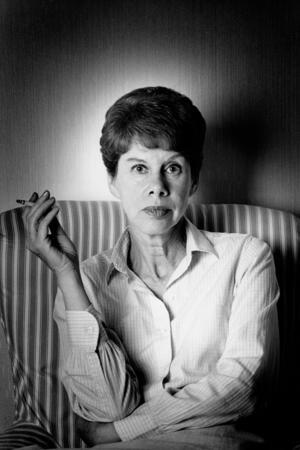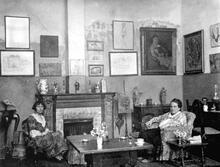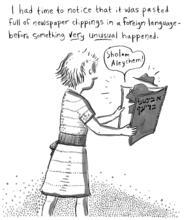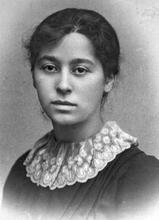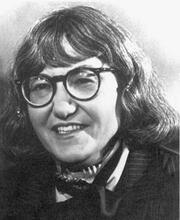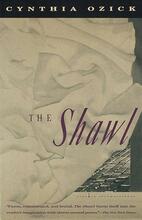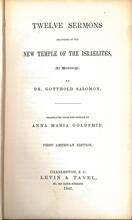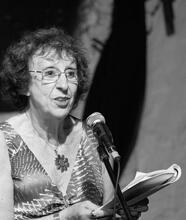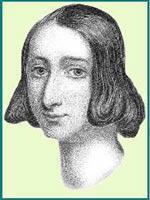Anglo-Jewish Writers in the Twentieth and Twenty-First Centuries
Anglo-Jewish women writers have had a relevant voice in the British literary panorama since the turn of the nineteenth century, but it was not until the 1960s and 1970s that the critics, the readership, and the authors themselves began to be seen as active agents shaping the contemporary literary canon. In the 1990s, these writers left the social and literary margins more forcefully and their creations have been essential to understanding the nature of diaspora, trauma, and exile in the twentieth century. The turn of the millennium meant a breaking of boundaries for Anglo-Jewish women writers, in formal, thematic, and political terms, reflected in a vast production of (semi)autobiographical and fictional creations trying to decode what it means to be a Jewish woman in our global world.
Introduction
Although Anglo-Jewish women writers have been active creators within the British literary arena since the late nineteenth and early twentieth century, and the 1960s and 1970s saw the emergence of a number of Jewish female voices, not until the 1990s did the works of Jewish women writers begin to be recognized as part of the British literary canon. At the turn of the millennium, these women began to make sense of their own and their families’ experiences of immigration and the Holocaust and to explore their femaleness more explicitly. Anglo-Jewish women writers’ multifaceted perspectives are reflected in a literary production characterized by experimentation and fragmentation. Their writings during the first decades of the twenty-first century show an invigorated interest in embracing transnational and transcultural concerns, as well as a call for new conceptions of the Jewish woman both inside and outside religious circles.
Before World War I and World War II: Alienated Voices in Search of Identity
Even prior to the twentieth century, a number of Anglo-Jewish women writers played important roles in the Victorian literature. Authors such as Amy Levy (1861–1889), Grace Aguilar (1816–1847), Emily Marion Harris (1844–1900), and Lily Montagu (1873–1963) were integral to the development of the Jewish novel (Valman, 2014). Anglo-Jewish women poets who followed the traditions of the sisters Marion and Celia Moss—Grace Aguilar, Amy Levy, Katie Magnus (1844–1924), Alice Lucas (1851/2-1935), and Nina Salaman (1877–1925)—approached the construction of a female Anglo-Jewish literary identity from diverse perspectives, such as that of Descendants of the Jews who lived in Spain and Portugal before the explusion of 1492; primarily Jews of N. Africa, Italy, the Middle East and the Balkans.Sephardic Jews in the case of Aguilar, of Jews of German origin for Magnus, or even that of a lesbian Jew in Levy’s case.
In the early twentieth century, Naomi Jacob (1889–1964, Yorkshire) was a particularly prolific and open-minded author. She wrote family sagas, mainly for a working-class audience, combatting the antisemitism of the 1930s and contravening gender, class, and racial stereotypes. Some of her more popular novels were The Founder of the House (1930) and The Gollantz Saga (1935–1958). Recently the romantic novel Barren Metal (1936) has received renewed recognition due to its anti-racist principles, which contributed to counteracting “the racial hegemony of British culture during the interwar years” (Tylee 2006, 45). Written in 1936, this novel denounced antisemitism in Britain between World War I and World War II through the smart combination of melodrama, romance, and comic conventions. In addition, Jacob used it as a platform to voice her alliance with social feminism by creating a female protagonist who subverted patriarchal stereotypes while opposing Nazism.
Other important writers of this period are Gladys Bronwyn Stern (1890–1973, London) and Lily Tobias (1887–1984, Swansea). Stern wrote numerous novels, plays, autobiographical pieces, and works of literary criticism, but her most prominent work is the series The Matriarch. These books, inspired by her own family, describe wealthy Jewish families from Eastern Europe and Russia who settled in England and suffered the consequences of the economic crash of the 1930s. Tobias, the daughter of Polish-Jewish immigrants, echoed her own sense of alienation along with her cross-cultural background in such works as My Mother’s House (1931) and Tube (1935), where readers can find echoes of her political views. She was an activist for such causes as suffrage, peace, and Zionism. She joined the first Foundation of Women Zionists in Great Britain and then the Women’s International Zionist Organization, founded in 1920. It was her commitment to the Zionist cause that led her to move to Palestine with her husband in the 1930s.
World War II, the Holocaust, and Their Aftermath: Kindertransport Narratives and the Construction of the Anglo-Jewish Female Autobiographical Self
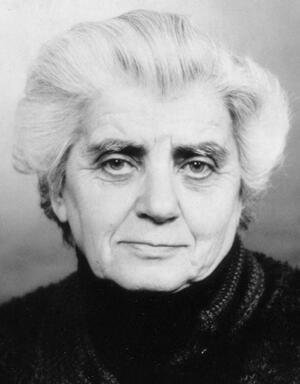
As a young girl, Karen Gershon (1923 – 1993) was sent from Nazi Germany to England on the Kindertransport. As an adult, she documented the trauma this experience engendered for herself and her fellow child refugees in We Came as Children: A Collective Autobiography (1966), which sparked extensive comment and established her literary reputation in England.
Institution: Naomi Shmuel.
Although some of the pre-war authors continued to flourish after World War II, the period immediately after the Holocaust was largely one of silence and obscurity for Jewish writers, who needed time to process before speaking out about the horror the Jewish people had endured. An exception was Betty Miller (1910–1965), an Irish Jewish author of literary fiction and non-fiction whose novels were written and set just before, during, and immediately after World War II. Works like Farewell Leicester Square (1941), On the Side of the Angels (1945), and The Death of the Nightingale (1948) portray English middle-class lives during this armed conflict and show the conflicting sides of female and Jewish identities. These novels revolve around issues of belonging and identity by exploring the boundaries between what it means to be an insider and an outsider within a given culture and depicting the difficulties in attaining a coherent identity in terms of race, gender, and class, even more so when these identity struggles happen during times of crisis and insecurity.
A number of post-war writers had arrived in England via the Kindertransport, through which the UK offered refuge between 1938 and 1940 to 10,000 children, mostly Jewish, from Nazi Germany and Central Europe. Kindertransport writers such as Karen Gershon (1923–1993), Lore Segal (1928–), Gerda Mayer (1927–2021), and Lotte Kramer (1923–) struggled with anxiety, guilt, and fear, caused by the traumatic experiences of separation, alienation, and family loss at a very early age. Their writings, mostly autobiographical, revolve around stories of escape and survival and offer a fruitful space to “raise new questions about flexing the boundaries of Holocaust representation” (Lassner 2008, 47).
After the Kristallnacht pogrom of November 9, 1938, Karen Gershon and her sisters were sent from Germany to the UK on a Kindertransport. Although she lacked confidence with the English language, Gershon was the first author in this group to publish her personal experience of the Kindertransport, first with her poetry collection The Relentless Year in 1959 and then in the form of collective autobiography with We Came as Children in 1966. All her works, including The Fifth Generation (1984) and Lesser Child (published posthumously in 1994), focus on the figure of the diasporic Jew by recalling the author’s own experiences. Gershon moved to Israel with her family after the Six-Day War (1967) but in the early 1970s she returned to England, where she further established her writing career.
Gerda Mayer fled Prague for England via the Kindertransport in 1939, when she was eleven. She began to write poetry at a very young age, first in German and then in English; she published numerous volumes of poems and her work appeared in several anthologies. Most of her creations reflect on the Kinderstransport and are concerned with migration, exile, the Holocaust, generational (dis)continuities, and loss. In contrast to Gershon, Mayer’s style is quite simple, and she makes smart use of irony to tackle traumatic issues.
Poet Lotte Kramer was born in Mainz, Germany, in 1923. Kramer came to England on one of the last Kindertransports and had to cope with the loss of her parents in the Polish ghetto of Piaski in 1942. The trauma of this loss, along with her feelings of alienation, kept her silent about her difficult childhood experiences until she published her first collection of poetry in 1979. Since then, her collections—some of the most representative being Family Arrivals (1981), The Desecration of Trees (1994), and Black Over Red (2005)—have been suffused with images of instability, rupture, and fragmentation. Her experimental poetry is in line with her own inner “lyrical exploration of exile” (Gilbert 2013, 60), which is achieved through the accumulation of images of loss and transience as well as of metaphors that symbolize exile, foreignness, and repressed traumas.
Although not rescued by the Kindertransport, Polish-British authors Janina David (b. 1930) and Kitty Hart-Moxon (b. 1926) are Holocaust survivors who wrote insightful autobiographical works. David endured poor living conditions in the Warsaw ghetto from 1939 to 1943; she survived, but her parents did not. She moved to Paris and Australia before finally settling down in the UK, where she became a pioneering Holocaust memoirist; her Square of Sky (1964) was a fascinating portrayal of life in Warsaw during the war. Moxon spent two years in the concentration camp of Auschwitz-Birkenau, beginning when she was sixteen. She and her mother migrated to Britain, where she devoted her life to bringing the Holocaust to public attention through her famous memoirs I am Alive (1961) and Return to Auschwitz (1981). David’s and Hart-Moxon’s writings were followed in the 1980s and 1990s by many other memoirs relating personal and collective Jewish stories of loss and survival during Nazism.
The 1960s to 1980s: Anglo-Jewish Women Find their Exilic Voices
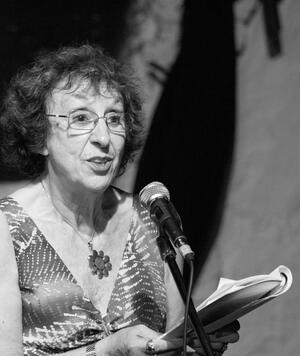
Elaine Feinstein reading at the Shaar International Poetry Festival in Tel Aviv, 2010. Photo credit Kaido Vainomaa, image courtesy of Wikimedia Commons.
The British literary scene of the 1960s and 1970s was characterized by an engagement with Modernism (the artistic style that emerged as a response to major socio-political changes in the late nineteenth and early twentieth centuries, which stood for innovation, experimentation, symbolism, and individualism) and the denial of realist aesthetics, resulting in an important trend of experimental fiction. The generation of British writers who emerged in the 1960s and 1970s, including John Fowles, Anthony Burgess, A.S. Byatt, Gabriel Josipovici, B.S. Johnson, and Christine Brooke-Rose, provided the link between Modernism and Postmodernism in Britain. Most of these writers were influenced by French Existentialism in trying to recuperate a metaphysical dimension of human experience in their creations. These authors had grown up during the World War II and reached maturity in the 1960s, a post-war background that influenced their urge to create new worlds through the imagination and that led them to share an interest in the nature of human consciousness. Like their Modernist predecessors, these British writers looked for a new type of fiction, which focused on the representation of the inner life of the individual. In this context, post-war British-Jewish writers who had experienced forced migration and struggled to find a stable identity in their new home began to explore Jewishness in their works by focusing on the inner lives of traumatized and/or diasporic Jewish characters and by relying on formal experimentation and fragmentation. This was as an echo of the alienation they had suffered as Holocaust survivors and/or Jewish exiles.
In contrast to the United States, where American Jews managed to connect with their new land’s past and enjoy their multiculturality with more freedom, British Jews were largely seen as spectators of a foreign culture. The monolithic Britishness contrasted with the United States as an immigrant nation characterized by a deep sense of mobility, and most British-Jewish writers have been aware of these differences. For instance, Linda Grant, in When I Lived in Modern Times (2000), portrays the character Evelyn Sert reflecting on these issues when she says: “I was a Jewish child in a country where, unlike America, there was no contribution I could make to the forging of the national identity” (12). Likewise, in The War After, Anne Karpf feels envious of the Jews who managed to form part of American culture (2008). These differences explain why American-Jewish women writers, represented by pioneers such as Cynthia Ozick and Grace Paley and followed by Pearl Abraham, Allegra Goodman, Tova Mirvis, Rebecca Walker, and Linda Pastan, among others, began to deal with more complex questions of race, sexuality, gender, ethnicity, and the fluidity of identity in the United States earlier than their British counterparts. Nevertheless, it should be borne in mind that the tension between self-assertion and self-denial is “an essential topic both in British- and American-Jewish literature” (Brauner 2001, 29).
Bernice Rubens (1923–2004), born in Cardiff of Russian-Jewish descent, had a vast fictional oeuvre that largely focuses on the topic of the family. She always explored her Jewish background and attempted to incorporate the notion of diaspora into her work. The figure of the child genius is at the center of Rubens’ best-known novels, Madame Sousatzka (1962) and the Booker Prize-winning The Elected Member (1969). Although she does not deal explicitly with the Holocaust, it lies underneath her stories in their claustrophobic scenarios, their symbolist style, and their challenge to both Jewish and English cultural norms by creating characters who cannot be easily classified as either pure Jewish or British subjects and who subvert the stereotypes that are usually ascribed to them. For example, the main character of The Elected Member, Norman, the son of a well-known rabbi in the East End of London, breaks with all the clichés expected from him as a brilliant Jewish child prodigy when he turns out to be a drug addict and mentally ill in his forties as a result of being brought up in a dysfunctional family.
Like Rubens, Anita Brookner (1928–2016), born in England to Polish-Jewish immigrants, also chose the family as her major subject. Her novels are built around characters possessed by haunting memories. Although she rarely referred explicitly to Jewishness or the Holocaust, she did introduce these topics indirectly. Like Brookner herself, most of her characters are the children or grandchildren of European Jewish exiles, and their Jewish backgrounds play central roles in their identity construction. This troubling relationship with Holocaust memories reflected the fact that subsequent generations of Holocaust survivors often act as the recipients of their ancestors’ traumatic and diasporic memories, through their silences or repetitive stories, and of the collective memory of the Holocaust. Thus, although they long to establish a solid connection with their predecessors, they tend to feel alienated from their relatives. They struggle with feeling tied to their ancestors’ difficult experiences of loss, migration, and exclusion, as they themselves did not witness them. This is especially evident in Brookner’s Latecomers (1988), A Family Romance (1993), and The Next Big Thing (US: Making Things Better, 2002). Brookner, along with Bernice Rubens, Elaine Feinstein, Maisie Mosco, and Claire Rayner, was among the most productive Jewish writers within the so-called genre of the “family saga” (Tylee, 2006). These “family saga” novels usually trace a Jewish family in Britain through several generations. These families are portrayed as being in a state of anxiety in the post-Holocaust period and as bound to traditional values, which become a burden for Jewish women. The family may appear either as a scene of generational conflict or as a source of happy continuation.
Michelene Wandor (b. 1940, London) is an English writer, lecturer, and musician whose parents were early twentieth-century Russian-Jewish émigrés. Wandor has been heavily involved in the Women’s Liberation Movement since the end of the 1960s, as proven by the success of her collection of essays The Body Politic (1972) and Once a Feminist (1990). Her main research interests are music and theater, and she is mostly known for her poetry, drama, and musical performances. Her writing has been primarily informed by her Jewish cultural heritage, her interest in English history, and the biblical tradition, as well as her feminist principles, as her polyphonic collection of short stories False Relations (2004) demonstrates.
Lynne Reid Banks (b. 1929, London), whose books have been giving voice to dispossessed and diasporic characters since the 1950s, was a pioneer among her generation. Banks is mainly known for her contributions to children’s literature, such as the popular The Indian in the Cupboard series (1980–1998). Her novels, including The L-Shaped Room (1960), Children at the Gate (1968), and Maura’s Angel (1984), depict convoluted experiences related to life on the margins, possibly drawing upon her own experiences of migration to Canada at to the onset of World War II and of life on an Israeli A voluntary collective community, mainly agricultural, in which there is no private wealth and which is responsible for all the needs of its members and their families.kibbutz before returning to England in the 1970s. Children at the Gate uses the diary form to unveil the story of a half-Jewish woman, Gerda, living in a state of self-destruction. Gerda has suffered first the loss of her son, and then the loss of feeling that she belongs to a nation or a country – the hope to which she attached herself when migrating to Israel after this traumatic event. The traditional clash between the Arab and the Jew is depicted in antagonistic terms in this novel, and this antagonism increases for those characters that do not belong to a pure race and who become, then, misfits. In fact, this issue becomes more relevant during Gerda’s stay in the kibbutz, the place where she is constantly reminded of her strangeness.
Leila Berg (1917–2012, Salford) was mainly a children’s author, a journalist, and a specialist in children’s education, as evidenced by her non-literary work Children’s Rights (1971). The influence of growing up in a Jewish doctor’s family in a Jewish immigrant neighborhood in Salford can be observed in her autobiographical work Flickerbook (1997), in which she uses a mixture of genres, combining pictures, diary entries, historical records, songs, and more to revisit her traumatic childhood and her entry into adulthood during the pre-war and wartime periods.
Muriel Spark (1918–2016, Edinburgh) was an acclaimed experimental writer of fiction, poetry, and literary criticism. Sparks’ status as a Jewish author has been debated; she always declared she was only partly Jewish, but some historical records demonstrate she was fully Jewish. Her first novel, The Comforters (1957), did not appear until she was 40, but she then became an extremely prolific writer. Spark published 21 novels, three volumes of short stories, a collection of poetry, and some plays and children’s works—an extensive amount of high-quality work that earned her the title of Dame of the Order of the British Empire in 1993. Her internal struggles with Jewish identity are most prominent in works such as The Mandelbaum Gate (1965), in which she experiments with Jewish issues both thematically and formally in a spirited and disturbing way. Set in 1961, the year the Eichmann trial took place in Israel, the novel presents a half-Jewish heroine who, like the author herself, is deeply affected by these events and who questions her Jewishness throughout the narration. The Mandelbaum gate symbolises the division of the city of Jerusalem at that time as well as the internal identity crisis suffered by the protagonist, who has also been read as an alter ego of Spark.
Prominent Jewish poets of this generation include Elaine Feinstein (1930–2019, Bootle) and Ruth Fainlight (b. 1931, New York). Feinstein, a second-generation Russian-Jewish immigrant, was also a novelist, a radio and television playwright, and a translator. The importance of the Holocaust for her construction of Jewishness is reflected in all her works, although often in subtle ways. In novels such as Children of the Rose (1974), The Survivors (1982), and The Border (1985) and in her multiple collections of poetry, Feinstein combined her attachment to the English literary tradition, mainly to the Romantic period, with the portrayal of dislocated experiences of migration and her invocation of the continuity provided by her Jewish heritage. Through her writing, she attempted to transcend the restrictions imposed by Anglo-Jewish culture and create different artistic spaces. For her, both Jewishness and femaleness embody intertwined categories of otherness that she tried to articulate through her literary practices. Thus, she voiced some feminist claims by calling on Jewish women to depart from a male-centered culture and the domestic female roles and embrace the opportunities provided by their hybrid and often marginal positions.
Eva Figes (1932–2012, Berlin), Judith Kerr (1923–2019, Berlin), Silvia Rodgers (1928–2006, Berlin), and Eva Tucker (1929–2015, Berlin) all shared German origins and a common experience of cultural and linguistic exile. Eva (Unger) Figes was born in 1932 into a family of assimilated German Jews who were forced to migrate to Britain in 1939. She established her career as a writer in London, and the traumatic loss of her maternal grandparents in the Holocaust, her feelings of estrangement in Britain, and the experience of being a writer in a patriarchal society all suffuse her vast literary career, which comprises thirteen novels, three (semi)autobiographical works, four critical works, short stories, radio and TV plays, children’s books, translated works, and literary essays. Her complex modernist style characterizes works like Konek Landing (1969) and Ghosts (1988), while the stream of consciousness of deeply traumatized characters is at its best in Winter Journey (1967) and Days (1974). Figes’ position as a foreign-born Jew in Britain is clearly illustrated in such autobiographical works as Little Eden (1978) and Tales of Innocence and Experience (2003). Her manifesto Patriarchal Attitudes (1970) made an important contribution to the second-wave feminist movement, as she offered a detailed analysis of the different socio-historical institutions that had consolidated patriarchal values in Western society and relegated women to a secondary position. Figes’ feminist facet reminds us that most of her contemporaries were also involved in the feminist cause in one way or another. Thus, they portrayed characters at odds with the roles that society and the Jewish family ascribed to them and created powerful and complex female protagonists in their novels.
Judith Kerr arrived in the UK in 1936 under similar circumstances to Figes. She became especially famous for her work as a children’s author, with books such as The Tiger Who Came to Tea (1968) and the trilogy of When Hitler Stole Pink Rabbit (1971; made into a feature film in 2019), Bombs on Aunt Dainty (1975), and A Small Person Far Away (1978). These three books offer a child’s outlook on the period from the rise of Nazism to the Cold War and the experience of being a German refugee in the Holocaust era. The trilogy is still used in German and British schools as a powerful tool to bring this historical period to life for the younger population.
The 1990s and the Turn of the Century: Anglo-Jewish Women Embracing their Jewishness and Femininity
Prior to the 1990s, most Anglo-Jewish women writers had existed on the margins of the British literary canon; not only had others excluded them from it, but many had removed themselves because they did not feel completely integrated into British artistic circles. In the 1990s, however, many Jewish women writers began to talk more openly about their troubled Jewish identities and Holocaust experiences. The authors contributing to this “boom” of British-Jewish works came from a variety of backgrounds and belonged to different generations, but their writing shares many features. Most of their works are concerned with the history of World War II and the Holocaust, which appears as a haunting presence, with trauma transmitted from one generation of the family to the next. Their works show obvious signs of foreignness and raise questions about the Jewish identity of their protagonists. They also feature formal experimentation, as the authors overtly expose their personal difficulties connecting themselves with the traumatic experiences undergone by their relatives. Moreover, even though writers such as Eva Figes and Michelene Wandor were already relevant figures in Second-Wave feminism in Britain in the 1970s, it was in the 1990s that most Anglo-Jewish women writers started to tackle gender issues more openly in their literary creations. In this regard, Judith R. Baskin claimed that Jewish women often “participate as ʽothersʼ in several traditions at once” (1994, 21), both “women in a male-dominated culture” and Jews in a Christian society. These arguments have been supported by contemporary Jewish feminists demanding new conceptions of the Jewish woman both inside and outside religious circles. They have asked themselves how Jewish women can assume a role that largely excludes them from the religious sphere but that assigns them the responsibility of keeping the Jewish family together. This double-sided aspect of women’s role within Jewish society turns the familial sphere into the center of Jewish women’s struggles to achieve an independent view of themselves. It is unsurprising, then, that the family figures prominently in Jewish women’s writings of this period.
Some writers, such as Anne Karpf (b. 1950, London), Louise Kehoe (b. 1949, England), Lisa Appignanesi (b. 1946, Łódź), Eva Hoffman (b. 1945, Kraków), and Rachel Lichtenstein (b. 1969, London), continued the experimentation with the form of memoir initiated in previous decades. Sociologist and journalist Anne Karpf and her sister Eve were brought up listening to their parents’ stories of Holocaust survival. Their accounts marked Karpf’s life both at the personal and professional level, and she has devoted a great part of her research to studying the Holocaust. Her liminal autobiographical book The War After (1996)—a combination of testimony, history, politics, psychological analysis, and memoir—is the culmination of this long personal and academic quest.
Louise Kehoe is an English-born writer of Russian-Jewish descent on her father’s side. Her most popular work is her memoir In This Dark House (1995), which won the National Jewish Book Award in 1995 and the UK’s Jewish Quarterly-Wingate Prize in 1997. In this work, Kehoe mixes fictional, testimonial, autobiographical, and historical elements along with letters, diaries, poetry, songs, and photographs. Her second-generation memoir acts as the narrative device to explore her father’s biography, as well as the family’s history of migration to England in 1939 and the transgenerational transmission of trauma suffered by Kehoe and her siblings.
The writings of Lisa Appignanesi, a British-Canadian Jewish writer and psychoanalytic critic based in London, also explore transgenerational Holocaust memory. Born in Poland in 1946, Appignanesi moved to France, Canada, and the UK, where she settled in 1967, experiencing the perils of migration and the burden of the Holocaust inherited from her parents. Her family memoir Losing the Dead (1999) received significant attention at the turn of the millennium; it exemplified the hybrid nature of most of her writings as a combination of bildungsroman, travelling book, family memoir, a collective account of many Jews who survived the camps, and a historical narrative about wartime Poland. Appignanesi’s fictional The Memory Man (2004), which won the 2005 Holocaust Literature Award, portrays a notorious neuroscientist who comes across repressed childhood memories that reveal him to be a Holocaust survivor. Here, Appignanesi revisits the topic of her family memoir, which explains the reason why there are numerous textual and paratextual parallelisms between the two texts.
Like Appignanesi, Eva Hoffman was born in Poland in 1945 and moved to Canada and the United States with her family before they settled in London in 1959. Hoffman’s autobiographical Lost in Translation (1989) explores her experiences of migration and her linguistic and cultural alienation in England. Her acclaimed memoir After Such Knowledge (2004) is a compelling representation of the notion of “postmemory” (Hirsch 2008) and a perfect example of the challenges encountered by descendants of Holocaust survivors who inherit the collective burden of Holocaust memory.
Writer, artist, and activist Rachel Lichtenstein is internationally famous for her books, multi-media projects, and creations, which explore notions of place, memory, and Jewish identity. She first became popular thanks to Rodinsky’s Room, co-written with Iain Sinclair in 1999. The novel tells the story of David Rodinsky, an Orthodox Jew who lived in a room above the Princelet Street Synagogue in London’s East End that was left untouched for 20 years. The text intertwines Lichtenstein’s trips to Poland, Israel, and Jewish London with Sinclair’s reflections on Lichtenstein’s quest into her own past. This work, along with others such as On Brick Lane (2007), demonstrates that this author, belonging to the younger generation born in the late 1960s and 1970s, “articulates a relatively solid connection to Britishness but a far less confident sense of her own Jewishness” (Gilbert 2013, 145). Her texts display a widespread tendency in this generation of British-Jewish writers to regret the loss of a shared, though abstract, Jewish past. For example, in Rodinsky’s Room readers discover that Lichtenstein’s mother is not Jewish and thus, following the Orthodox norms, Lichtenstein should not be considered as such either. This writing aims to confront this hidden facet of the author’s personality, showing the tensions between her assimilated English identity and the nostalgic ideas of what it means to be a Jew in the East End. As the narration advances, this tension turns into a more broadminded perspective by showing how today’s British-Jewish generations seem to miss the cultural individuality that Jewishness offered them. As Ruth Gilbert has rightly commented, “Rodinsky’s Room inaugurates a discussion about, not what it means to be Jewish and perhaps not quite British; but what it means to be British and perhaps not quite Jewish” (146).
The so-called “third generation” of British-Jewish women writers is also well represented by Linda Grant (b. 1951, Liverpool), Jenny Diski (1947–2016, London), and Zina Rohan (b. 1946, London), as these authors “took centre stage” in the British literary panorama during the 1990s by “adding their voice to British Jewish literature and history” and “exploring their families’ past and their Jewishness” in their works (Behlau and Reitz 2004, 12).
Writer and journalist Linda Grant is the child of Russian- and Polish-Jewish immigrants and the grandchild of Holocaust survivors. Grant’s works exemplify many of the Jewish family frictions and the problematic definition of Jewish womanhood characteristic of this generation’s writing. Since her first publication in 1993, novels such as The Cast Iron Shore (1996), When I Lived in Modern Times (2000), Still Here (2004), and We Had It So Good (2010) have recreated Jewish and female concerns by telling the stories of Jewish women reinventing themselves through multifarious journeys of discovery. Grant’s depictions of these journeys often denounce the many frictions Jewish women must still negotiate to feel comfortable with their social roles and to have a voice within Jewish tradition. She also explores these issues by experimenting with other genres, such as memoir in Remind Me Who I Am, Again (1998) and literary reportage in The People on the Street (2006). In her novel A Stranger City (2019), Brexit acts as a nodal point (dis)connecting diasporic characters, both Jewish and non-Jewish.
Jenny Diski was born to working-class Jewish immigrants in London within a troubled family; her father abandoned them when she was six and, consequently, her mother suffered a nervous breakdown, which cost her custody of her daughter. Diski was put into foster care and later taken in and mentored by famous novelist Doris Lessing, who helped her pursue an education at University College-London, and she worked as a teacher during the 1970s and 1980s. Diski published a collection of stories and ten novels and was well-known for her regular contributions to the London Review of Books; her travel books Skating to Antarctica (1997) and Stranger on a Train (2002), which combine traits from the genres of memoir and philosophical essay; and works of popular history, such as The Sixties (2010). Diski’s initial works dealt with complicated issues, like depression and sado-masochism, and she often depicted the disrupted Jewish family as a place of refusal and disloyalty. Her autobiographical works, along with those by Figes and Grant, can be defined as “self-questioning works that disrupt the conventional self/other, mother/daughter binaries in favour of a more interrogative, sceptical inquiry into the relationship among identity, memory, motherhood and ethnicity” (Brauner 2014, 212).
Zina Rohan was born in London and grew up in a very international family; her father was a German Jew and her mother a Russian immigrant born in Serbia. In the 1990s, while working as a BBC reporter, she published The Book of Wishes and Complaints (1991) and The Sandbeetle (1994), the novels that marked the beginning of her literary career. Her more recent publications, The Officer’s Daughter (2007) and The Small Book (2010), reflect some common issues in her novels: migration, displacement, and the intricate crossing of frontiers by alien characters; the lack of choices that individuals have when caught in any war; and the multidirectional and transgenerational links identified in a variety of conflicts.
Some of the writers stated above, such as Anne Karpf, Lisa Appignagnesi, and Jenny Diski, joined the organization “Independent Jewish Voices,” launched in February 2007 by 150 relevant British Jews. Prominent intellectuals of the time came together to sign a declaration of the basic principles of their ideology. They published a collection of essays, A Time to Speak Out: Independent Jewish Voices on Israel, Zionism and Jewish Identity (Karpf, Klug, Rose, and Rosenbaum 2008), in which they explained that the main goal of their declaration was to put “human rights first, rejecting all forms of racism, respecting international law, and treating as equally legitimate the Palestinian and Israeli quests for a better—a peaceful and secure—future” (ix). This group of thinkers tried to detach themselves from the Israeli government that claimed to represent Jews in general and from the British-Jewish position, which has usually supported the politics of the Israeli government. Although they embraced their Jewish identities, they did not want to be identified with the Israeli politics of violence exerted upon the Palestinians in the Gaza Strip and rejected any form of abuse and racism.
The urgency of this debate also reverberated in the literary productions of some of these writers to the extent that the history of Israel and the Israeli-Palestinian conflict became a relevant topic for them. Just as the writers of the 1970s attempted to find roots in their adoptive homes by setting against each other the history of Britain and the Holocaust, so those writers at the turn of the century felt the need to understand the creation of Israel and the many Jews who emigrated in the hope of finding there a better future and a Promised Land. Some examples can be found in Figes’ Journey to Nowhere (2008), Grant’s When I Lived in Modern Times (2000), and Rubens’ The Sergeants’ Tale (2003). Set in Palestine before and after the Declaration of the State of Israel in 1948, these works deal with Zionism, anti-Semitism, and the creation of Israel while addressing the fate of those Jews who tried to find a new home in the new state after the Holocaust. In most cases, the experiences of migration to Israel are portrayed as leading to disillusionment and increasing questioning of the essence of Jewishness. For example, Edith, the Jewish maid in Journey to Nowhere, depicts the experience of living in Israel as something that “ran contrary to everything that the new Israel was supposed to stand for, to the smiling faces I had seen on the newsreels” (Figes 2008, 107), while the main character of Grant’s novel asserts that “It is always other people who define what a Jew is” (2000: 60). When I Lived in Modern Times tells the story of a British-Jewish girl, Evelyn Sert, who migrated to Israel in search of her Jewish roots but only found a place where she did not fit. Although it is a fictional account, When I Lived in Modern Times shows significant historical events, including post-Holocaust Jewish migrations, the Zionist movement and the violent acts derived from it, the creation of the State of Israel, and the way of life on the kibbutz, rendered from an individual female perspective.
The interest of British-Jewish writers in the conflict in Palestine must also be seen in the wider historical context of the longstanding relationships between the UK and the Middle East. One of the most important studies of the relationship between Britain and the Israeli-Palestinian conflict is Jacqueline Rose’s States of Fantasy (1996). In this work, she argues that Palestine and Israel have shaped the imagination of British-Jewish women’s fiction, mainly in relation to the troubling period at the end of the Mandate when some Zionists attacked British soldiers.
Around the turn of the twenty-first century, theater also became a fruitful arena for Jewish women authors—such as playwrights Julia Pascal (b. 1949, Manchester), Diane Samuels (b. 1960, Liverpool), and Deborah Levy (b. 1959, Johannesburg), all born or raised in post-war Britain—to explore the question of responsibility for the annihilation of European Jews. These three writers’ works focus more on the collective than the individual dimension of Holocaust memories. They can be considered “cosmopolitan” because they demand the revision of Holocaust memory in contexts “both inside and outside national ʽimagined communitiesʼ, whether those of their Jewish heritage or of their adopted British homes” (Tylee 2006, 226–227). The Jewish women represented in their plays are not simple representations of either Jewish or British women but rather hybrid and fluid figures.
Julia Pascal, born in Manchester in 1949 into a family of Romanian- and Lithuanian-Jewish origins, was raised in Lancashire and London. She worked as a dancer and actress before becoming a theater director. In fact, in 1978 she became the first woman to direct at the National Theatre, when she staged an adaptation of Dorothy Parker’s writings Men Seldom Make Passes. Her plays Theresa (1990), A Dead Woman on Holiday (1991), and The Dybbuk (1992) tackle the topic of the Holocaust in a straightforward manner. Her plays Year Zero (1996), The Yiddish Queen Lear (1990), and Woman in the Moon (2001) are set in Europe during World War II. (These plays were not initially conceived as a trilogy, but they were performed as such in 1995 and received as such by the audience and critics.) Pascal’s works establish connections between the Holocaust and preceding and successive genocides. This multidirectional dimension can also be observed in other works, such as Crossing Jerusalem (2003), in which she connects an Israeli and a Palestinian family through the Iraq war.
Diane Samuels was born in Liverpool in 1960 and became a full-time writer in 1992, thanks to her expressionistic play Kindertransport, first staged in 1993. Here, Samuels focuses on the losses, traumas, and gaps that Kindertransport children had to face to assimilate into British culture. She does so by portraying a complex mother-daughter relationship in which the mother has repressed her painful Holocaust memories, which are then unavoidably unveiled by her daughter through a painful process. This process also represents the tensions between English and Jewish heritage that many subsequent generations of Jews confronted in England.
Novelist, playwright, and poet Deborah Levy moved from Johannesburg to England in 1968 and has lived there ever since. She first focused on writing for the theater, mainly for the Royal Shakespeare Company, and later wrote novels, such as Beautiful Mutants (1989) and Swallowing Geography (1993). Her more recent novels were shortlisted (Swimming Home, 2011) or longlisted (The Man Who Saw Everything, 2019) for the Booker Prize. She has also written some autobiographical works, such as Things I Don’t Want to Know (2014) and The Cost of Living (2018). Most of Levy’s works feature hybrid and fluid female protagonists transgressing or living on different borders, physical, spiritual, and/or linguistic; this aspect is also reflected in her interest in formal and generic experimentation.
The New Millennium: Opening Up to the Transnational World
The arrival of the new millennium made evident the disintegration of boundaries between the center and the margins in a global world where borders and distances have become both more obvious and less relevant because of travel and migration, and structures less fixed because of the digital age. In this context, reading the works by Anglo-Jewish women writers from a more transnational perspective, connecting them with other groups of women who have gone through similar experiences of diaspora and migration, can help to identify the intersection of mechanisms that have made them feel oppressed and excluded. Applying an intersectional feminist reading to current Jewish women’s writings reveals that in order to understand the repression they have suffered, it is essential to consider the multifarious mechanisms configuring their identities—not only gender, but also class, sexuality, race, etc. Today intersectionality has pervaded feminist studies at all levels, but the term “intersectionality” was developed by black American feminists in the late 1980s when they criticized the white, Western, middle-class feminist discourses that tended to omit issues of racism and neo-colonialism in order to satisfy their middle-class interests. Jewish feminism also demands an intersectional analysis, especially an antiracist analysis that considers ethnicity and race as power differentials marginalizing Jewish women, because patriarchal, classist, and racist discourses are entangled and often leave Jewish women relegated to the margins of society and culture (Brettschneider 2016).
Many of these questions suffuse contemporary Jewish feminism, which denounces the fact that Judaism and Jewishness have often represented values associated with patriarchy and highly traditional notions of home, family, and community. By the turn of the millennium, Marsha Berkman and Elaine Starkman, for example, claimed that numerous Jewish women had recently started writing works “infused with a forceful sense of independence” (1998, 5). Although most of these voices have belonged to American Jewish women, British-Jewish authors are joining the fruitful transnational dialogue with other minority groups who have similar experiences of oppression worldwide. Some of the authors who contributed to the boom in Jewish writing in the 1990s, such as Linda Grant and Rachel Lichtenstein, already exemplified this tendency in their writings published at the turn of the century, as in Grant’s The Cast Iron Shore (1996) and When I Lived in Modern Times (2000), and more explicitly in their twenty-first-century creations, such as Still Here (Grant 2004) and On Brick Lane (Lichtenstein 2007). Yet fresh voices have appeared on the literary scene. Authors like Naomi Alderman (b. 1974, London) and Charlotte Mendelson (b. 1972, London) have become very popular because they promote new models of Jewish identities that are not exclusively controlled by the traumatic Jewish past. If in the 1990s Sarah Silberstein and Margie Wolfe claimed that “for many Jewish women today, there is a keen sense of loss, of the lack of our own female history, heritage and traditions. We have few role models from the past; our achievements and contributions as Jewish women have rarely been acknowledged” (1998, 11), these very contemporary writers seem to be responding to this urge to create female Jewish models that can help Jewish women redefine themselves in our global and interconnected world.
Novelist and game writer Naomi Alderman, born to an Orthodox family, exemplifies the fresh voices experimenting with form, voicing marginal stories, and addressing controversial issues. Her Orange Prize-winning novel Disobedience (2006) has been categorized as the “most transgressive novel by a British Jewish woman writer in recent years” and as “point[ing] toward new directions for British Jewish women’s writing at the beginning of the twenty-first century” (Valman 2014, 7) because of its depiction of a lesbian relationship between Jewish women within the circle of contemporary North London ultra-Orthodoxy. Alderman’s The Lessons (2010) and The Liars’ Gospel (2012) were followed by The Power (2016; winner of the 2017 Baileys’ Women’s Prize for Fiction), which has received the most critical attention. The Power, which is presented as a historical novel discovered in the future, can be read as speculative fiction written from a feminist perspective. The book revolves around the year 2018, when teenage girls worldwide discover they have physical supremacy over men due to their capacity to electrocute them, which leads to the reversal of the social, religious, political, and individual distribution of power. Alderman counteracts women’s feelings of fragmentation as she proposes a new world where women are interconnected globally through their power to hurt men. Her turning male-controlled civilization upside down allows readers to imagine a post-, or even pre-, patriarchal global system, but although this system aspires for hybridity and plurality, the deconstruction of gender binaries can also be questionable. Here, women's liberation comes at the cost of men's subordination, which leaves no room for the representation of an egalitarian society between men and women.
Writer and journalist Charlotte Mendelson has published novels, non-fiction, and other literary and radio works. Her second novel, Daughters of Jerusalem (2003), won the Somerset Maugham Award and the John Llewellyn Rhys Prize, and she was shortlisted for The Sunday Times Young Writer of the Year award. Her next piece, When We Were Bad (2007), was shortlisted for the Orange Prize for Fiction and chosen as a book of the year by diverse literary journals. This work has been analyzed along with Alderman’s Disobedience, since they are set in the same area of London and depict contemporary British-Jewish lives, although Mendelson does so from a less Orthodox perspective. Both novels also deal with the limitations imposed by the Jewish family and culture, explore their protagonists’ need to transgress their social roles, and display insight into Jewish women’s sexual desire. Mendelson’s latest novel to date, Almost English (2013), was longlisted for the Man Booker Prize and the Baileys Women’s Prize for Fiction. This book addresses the complex feelings of alienation embodied in its young female protagonist, as well as the intricate relationships constructed among the different generations of Hungarian-Jewish women represented in the narrative.
Olivia Lichtenstein (b. 1960, South Africa), based in West London, is an award-winning documentary filmmaker who had an eminent career at BBC TV before she became a freelance documentary and drama director and journalist. In 2007, she published her popular novel Mrs Zhivago of Queen’s Park. This romantic fiction tackles the issue of long-term marriage from the perspective of a housewife going through a mid-life crisis that leads her to commit adultery. In this way, Lichtenstein turns some of the stereotypes associated with the figure of the Jewish mother upside down.
Writer and poet Joanne Limburg (b. 1970, London) is based in Cambridge, where she was a Royal Literary Fund fellow at Magdalene College (2008–2010) and Newnham College (2016–2017). After obtaining her PhD in Creative Writing at Kingston University, she taught at De Montfort University. Limburg’s first collection of poetry, Femenismo, was published in 2000. Since then, she has published various volumes of poetry as well as a collection for children. In 2011, she published the autobiographical The Woman Who Thought Too Much, a revealing memoir about the anxiety and OCD from which she has suffered throughout her life, especially after a traumatic miscarriage. Her subsequent memoir, Small Pieces, came out in 2017. Limburg’s first novel, A Want of Kindness, revolving around the figure of the eighteenth-century Queen Anne, was published between these two autobiographical works in 2015. In this fictional recreation, Limburg depicts the difficulties Anne experienced, highlighting her strength in recovering from loss and betrayal.
One of the newest authors on the Anglo-Jewish female literary scene is Francesca Segal (b. 1980, London), a writer and journalist who was brought up in Jewish North-West London and became popular thanks to her novel The Innocents (2012), which won several awards, including the 2012 Costa First Novel and the 2012 National Jewish Book Award for Fiction. Combining the features of romantic fiction features and guidebooks, in this case of the Jewish communities based in North London, Segal’s work tackles marriage, love, and family in funny and unexpected ways. Her novel has helped make British readers more familiar with current Jewish culture and challenged traditions and clichés.
Natasha Solomons, also born in 1980 in London, is the daughter of second-generation Jewish immigrants. Her grandparents escaped Germany in the late 1930s, arriving in London and then settling in Dorset. Solomons’ first novel, Mr Rosenblum’s List (2010), about an Austrian-Jewish immigrant and his wife who are refugees from the Nazis in unfriendly Britain, tackled her grandparents’ experiences and the memories she inherited from them, mainly through the topic of food. Here, food acts as a link to the past and the motherland for diasporic Jews like her German-Jewish grandparents. Mr Rosenblum’s List was followed by the well-received novels The House at Tyneford (2011) and The Novel of the Viola (2011). The TV rights for Solomons’ novel House of Gold (2018) were acquired in 2018, and her unpublished short story “Curtis Butterworth Loves Molly May” (2019) was adapted as a play. Her works largely echo her family history, mirror feelings of nostalgia, and address modern concerns about the construction of Jewish identity.
Literary editors Laura Phillips and Marion Baraitser made an important contribution to the “Jewish cultural renaissance” in Britain (Gilbert 2013, 131) and to the discovery of contemporary Jewish female voices by compiling a collection of short stories entitled Mordecai’s First Brush with Love (2004), where they unite such fresh authors as Erica Wagner, Elizabeth Russell Taylor, and Shelley Weiner, among others. Most of the stories in this book prove that the conditions of Jewish women in current Britain have improved, although they still face feelings of fragmentation and alienation in their British-Jewish hybrid socio-cultural backgrounds.
All in all, both the authors and the women represented in the texts mentioned above explore multifarious ways of being Jewish and female in contemporary Britain and demonstrate how the possibilities for Jewish women are more fluid and dynamic than ever before. Although the topics of the family, tradition, and identity are still prominent in many of their writings, today’s Jewish female writers are active and essential agents in the ongoing construction of British-Jewish culture and life.
Baker, Adrienne. The Jewish Woman in Contemporary Society: Transitions and Traditions. London: The Macmillan Press, 1993.
Baskin, Judith R. Women of the Word: Jewish Women and Jewish Writing. Detroit: Wayne State University Press, 1994.
Behlau, Ulrike and Bernard Reitz. Jewish Women’s Writing of the 1990s and beyond in Great Britain and the United States. M. U. S. E. 5. Trier: WVT Wissenschaftlicher Verlag Trier, 2004.
Berkman, Marsha L. and Elaine M. Starkman. Contemporary Jewish Stories: Here I Am from around the World. Philadelphia and Jerusalem: The Jewish Publication Society, 1998.
Brauner, David. The Edinburgh Companion to Modern Jewish Fiction. Edinburgh: Edinburgh University Press, 2015.
Brauner, David. “Jewish Mothers and Jewish Memory in Contemporary Memoirs.” In Jewish Women Writers in Britain, edited by Nadia Valman, 192-215. Detroit: Wayne State University Press, 2014.
Brettschneider, Marla. Jewish Feminism and Intersectionality. New York: SUNY Press, 2016.
Cheyette, Bryan. Contemporary Jewish Writing in Britain and Ireland: An Anthology. London: University of Nebraska Press, 1998.
Figesm Eva. Journey to Nowhere: One Woman Looks for the Promised Land. London: Granta Books, 2008.
Gilbert, Ruth. Writing Jewish: Contemporary British Jewish Literature. London, Basingstoke: Palgrave Macmillan, 2013.
Goldstein, Elyse. New Jewish Feminism: Probing the Past, Forging the Future. Woodstock, VT: Jewish Lights Publishing, 2009.
Grant, Linda. When I Lived in Modern Times. London: Penguin, 2000.
Hartman, Tova. Feminism Encounters Traditional Judaism: Resistance and Accommodation. Hannover and London: Brandeis University Press, 2007.
Hirsch, Marianne. “The Generation of Postmemory.” Poetics Today 29, nº. 1 (2008): 103–28.
Jelen, Sheila E., Michael P. Kramer, and L. Scott Lerner. 2011. Modern Jewish Literatures: Intersections and Boundaries. Philadelphia: University of Pennsylvania Press, 2011.
Karpf, Anne. The War After: Living with the Holocaust. London: Minerva, 2008 (1996).
Karpf, Anne, Brian Klug, Jacqueline Rose and Barbara Rosenbaum (eds). Independent Jewish Voices on Israel, Zionism and Jewish Identity: A Time to Speak Out. London and New York: Verso, 2008.
Las, Nelly. Jewish Voices in Feminism: Transnational Perspectives. Lincoln: University of Nebraska Press, 2015.
Lassner, Phillis. Anglo-Jewish Women Writing the Holocaust. Basingstoke: Palgrave Macmillan, 2008.
Lawson, Peter. “Otherness and Transcendence: The Poetry of Ruth Fainlight and Elaine Feinstein.” In Jewish Women Writers in Britain, edited by Nadia Valman, 135-155. Detroit: Wayne State University Press, 2014.
Rose, Jacqueline. States of Fantasy. New York: Oxford University Press, 1996.
Rothberg. Michael. Multidirectional Memory: Remembering the Holocaust in the Age of Decolonization. Stanford: Stanford University Press, 2009.
Silberstein Swartz, S., and Wolfe, M. From Memory to Transformation: Jewish Women Voices. Toronto: Second Story Press, 1998.
Stähler, Axel. Anglophone Jewish Literature. London: Routledge, 2007.
Tylee, Claire M. “In the Open”: Jewish Women Writers and British Culture. Newark: University of Delaware Press, 2006.
Valman, Nadia. Jewish Women Writers in Britain. Detroit: Wayne State University Press, 2014.
Vice, Sue. “Writing the Self: Memoirs by German Exiles, British-Jewish Women.” In “In the Open”: Jewish Women Writers and British Culture, edited by Claire M. Tylee, 189-209. Newark: University of Delaware Press, 2006.

